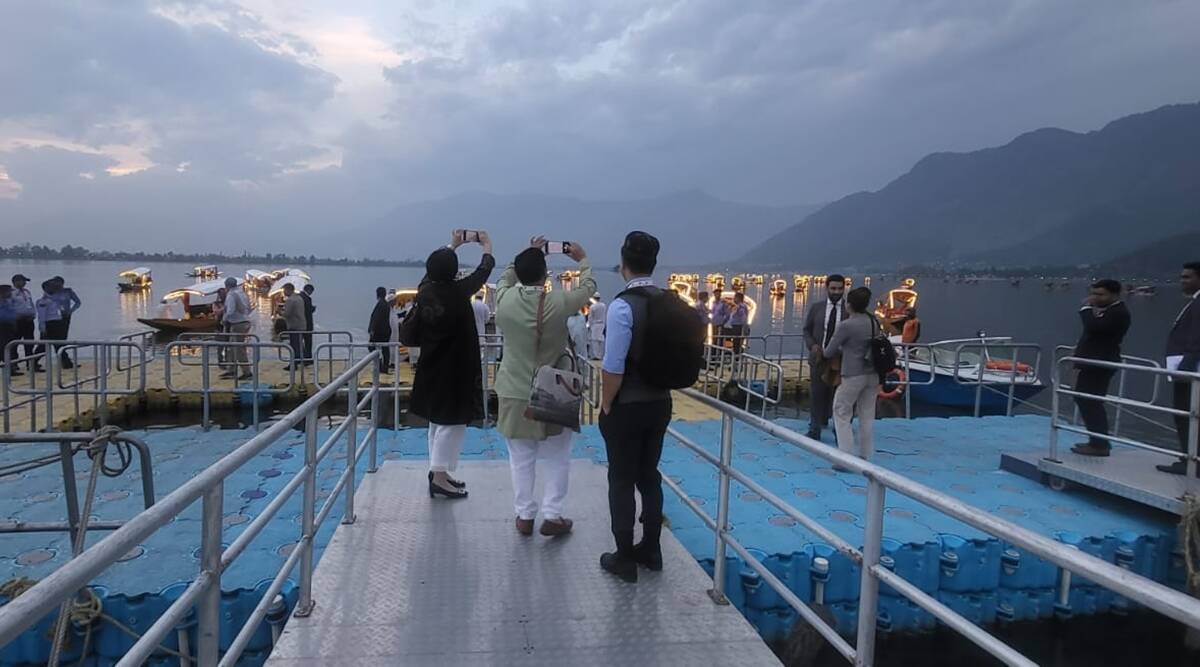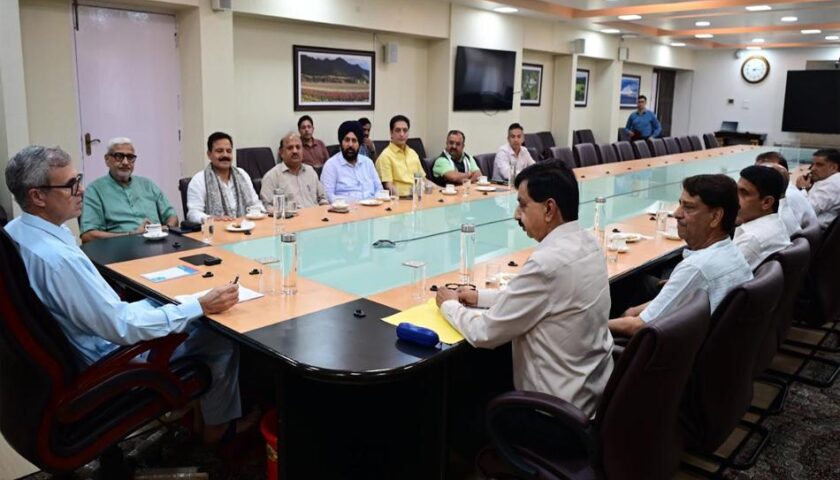Srinagar’s urban landscape is improving, with public spaces, pedestrian facilities, and tourist spots being revamped as part of the Smart Cities Mission. The city’s Polo View Market and Lal Chowk have undergone pedestrianisation and heritage buildings restored. The Jhelum riverfront has also been transformed into a walkable public plaza. The projects were delayed by security threats and civic problems, but most work was completed in the last year. The Srinagar Smart City Limited has taken up 125 projects with a budget of ₹980 crore, 56 of which are complete, with the rest expected to be finished by June 2022.
As you land at the Srinagar airport and move into the city, it becomes evident how efforts at improving the urban landscape have helped inculcate a feeling of normalcy.
Improved public spaces, better pedestrian facilities and revamped popular tourist spots such as the Dal lakefront, Jhelum riverfront, Polo View market and the Central Business District (CBD) around Lal Chowk stand out as Srinagar progresses as a modern city.
The revamp is part of the Smart Cities Mission by the ministry of housing and urban affairs (MoHUA). The mission was launched in 2015, and Srinagar was selected in 2016, and work started in early 2017. Battling security threats and civic problems that made it difficult to get desired vendors and contractor, the projects were delayed by about two years. The pandemic further delayed work during 2020 and 2021, officials associated with the city revamp said.
Also Read: Love in the Air: Discovering the Most Romantic Places to Visit in the Kashmir Valley
The officials added that most of the work was implemented in the last one year. The meeting of the G20 tourism working group meeting in Srinagar pushed deadlines. With a budget of ₹980 crore, the Srinagar Smart City Limited (SSCL) has taken up 125 projects, 56 of which are complete and the are expected to be over by June next year.
Polo View Market
It was one of the first projects to be taken up. A fully motorable stretch, it was a high street shopping area but frequented mostly by tourists only. It was revamped into a pedestrian-only stretch with the concrete road being replaced by cobblestones, and paver blocks and tactile tiles put in place for the differently abled. Retractable iron bollards on both ends of the road were installed to restrict vehicle entry, but allow access to emergency vehicles.
Officials said that heritage buildings along the road were restored and the façade of many shops renovated. One of the most important components of this project was shifting of all overhead wiring and other utilities underground and improving drainage to prevent flooding.
Also Read: Kashmir as a Honeymoon Destination: Top reasons why to choose?
“We used lessons learnt from the 2014 floods to prevent such damage. Polo View is one of the stretches that gets inundated every monsoon. We have created double drains here that will prevent flooding even during heavy rain,” said Athar Aamir Khan, commissioner, Srinagar Municipal Corporation (SMC), and the CEO of SSCL.
Lal Chowk
The commercial and political nerve centre of the city, Lal Chowk is known as much for its busy old market as the protests and other political activities. “Streets have traditionally been the hot spot of social, cultural, and economic activities, around which, life has revolved in cities. The active and vibrant street is an indicator of a safe and resilient city. The streets in Srinagar are marred by illegal parking, lack of safe space to walk, lack of lighting and haphazard placement of utilities,” said Anuj Malhotra, general manager (planning), SSCL.
The plan is to turn the historic square into a world-class plaza with pedestrian-friendly amenities. The Ghanta Ghar or the clock tower located in the centre of Lal Chowk was revamped and its elevation was raised by about 10 metres, with design changes and a new clock. Officials said according to the plan, one carriageway will be turned into an exclusive space for pedestrians and the opposite carriageway will have two lanes for the movement of vehicles with speed calming measures.
Additionally, 40 kilometres of road stretches emerging from Lal Chowk have been taken up for redevelopment with a special focus on ensuring pedestrian safety. “Shifting of overhead electrical wiring and other utilities underground in an old city is a huge task involving heavy cost. There was some resistance to addition of pedestrian facilities since locals argued that it was narrowing space for vehicles. However, once we were done, the congestion on these stretches was reduced. We reclaimed most of the space for pedestrians by removing haphazard street parking,” said Khan.
Also Read: Best Places for Destination Wedding in Kashmir
Jhelum riverfront
A wide unkempt green area on the banks of Jhelum was turned to a walkable public plaza with ample seating space, the officials said. “The emphasis was on improving the quality of public spaces so that they become friendlier and more welcoming for the common citizen, helping to improve interaction and social cohesion. The riverfront of Srinagar, along the banks of river Jhelum has been envisioned as a continuous eight-kilometre-long walking and cycling space, with linear parks and numerous activities sprinkled along the way,” said Khan.
The city authorities plan to integrate the riverfront with the Dal lakefront soon so that it becomes a continuous stretch. About 40 traditional ghats along the river that were lying defunct are also being redeveloped, and will be used as ports for water transport, SSCL officials added.
Connectivity and security
SSCL officials said that by the end of this month, Srinagar will launch a 175-kilometre-long optical fibre cable (OFC) network which is set to act as the “connectivity backbone” of the city. With 96 crore OFCs, the Srinagar Data Network or SDNet will be controlled from an integrated command centre, officials said, and added that the network is “glitch-proof with multiple layers for redundancy”. The entire network is underground and spans all 66 major traffic junctions, critical public infrastructure and government offices. The city will now be monitored using over 1300 cameras installed across the city by the municipal corporation, they added.
The integrated command centre will gradually integrate a total of nearly 10,000 cameras installed by the army, local police, the city development authority and other departments.
Lessons for Srinagar from Delhi
Delhi has experimented with pedestrian-only streets, improvement of façade, drainage and removal of encroachment – concepts that form the backbone of urban revival in Srinagar — in several areas, albeit with limited success.
Experts say that though it would not be prudent to compare the two cities because of the sheer differences in the size, population and number of vehicle, the real test of the revamp lies in sustainability.Urban planning experts have an inside joke. They say that every great project from across the globe has seen a pilot in Delhi. However, it is very difficult to achieve anything more than a pilot in the national capital.
The pedestrianisation of the Polo View market in Srinagar finds its parallel in the experiment at the Ajmal Khan Road market in Karol Bagh. Incidentally, the same team worked on implementing the concept in Karol Bagh and Srinagar.
Do Watch: Kya Karie Korimol With Kashur Wanvun – CokeStudio
Karol Bagh has received attention from the state as well as central government and efforts are being made to redevelop the area for about 15 years now. Karol Bagh pedestrianisation — involving a 1.7km stretch — was first approved by the Delhi LG in 2009 but the project did not take off. It was identified for model decongesting project by the Ministry of Home Affairs (MHA) with appointment of knowledge partners, one of whom was Anuj Malhotra, who is now the general manager of Srinagar Smart City Limited and has designed all of Srinagar’s projects. This project got final approval in 2019 after much effort. However, implementation has been slow and inconsistent. The design changes suggested have still not been fully implemented on the ground. The barricading is still temporary that allows people to shift it and take vehicles onto the pedestrianised stretch, while enforcement is also low.
“Consistent leadership and strong in-house planning team have helped Srinagar to achieve realisation of difficult projects like complete street development, riverfront and pedestrianisation of Polo View market. The idea of making streets on Complete Street principles was a new thing for Srinagar. There was initial resistance, but with constant dialogue with local stakeholders and after its full implementation it has become the project that has received wide acceptance. In Karol Bagh, Delhi it was similar, local stakeholders had given full support during the time of tactical implementation. One of the key elements to Polo View’s success was to move from tactical to full implementation in an unbroken sequence within a stipulated timeframe,” said Anuj Malhotra.
Also Read: Do’s & Don’ts for your Kashmir Trip
Experts say that Delhi does have any urban planner at any of its civic agencies, which is a drawback for the city.






